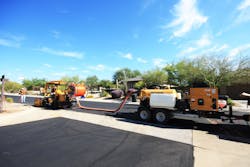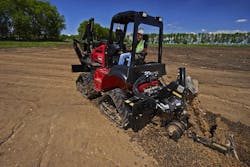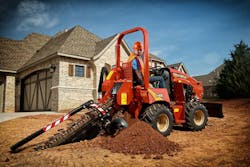The trencher market is trending up, and manufacturers are giving managers attachment choices for the host tractor to boost utilization.
Microtrenching has become increasingly popular for fiber installation. Above, a microtrenching train works on a residential street.
“The current market activity for trenchers in North America is positive, with growth slightly up from last year,” says Steve Seabolt, Ditch Witch product manager for heavy-duty tractors. “This is due in large part to a strong growth in the telecommunications industry with continued growth and need for equipment in energy markets.”
Seabolt says his company has seen growth in the more than 100-horsepower category of trenchers as customers continue to embrace newer T4-F models.
“The rental market continues to be a robust market for trenchers, and we see some growth there,” says Jon Kuyers, senior global product manager for Vermeer. “Also, the fiber industry relies on ride-on trenchers for installations.”
Vermeer has a microtrencher specifically for fiber installation in crowded urban underground areas. It can be used with the company’s compact RTX450, RTX550, or RTX750 ride-on tractors as part of a microtrench train. The Ditch Witch microtrencher system includes the MT12 or MT16, a choice of ride-on trenchers, and an FX65 vacuum excavator for the spoils.
The ride-on tractor concept has served the utility industry well, with trencher, microtrencher, cable plow, vibratory plow, reel carrier, rocksaw, and backfill blade attachments available to increase versatility and machine utilization.
Keys to the trencher buying decision
Whether going big or small with the trencher or allied equipment attachments, there are a number of factors to consider when it’s time to purchase, including soil conditions, and parts and service.
Seabolt stresses considering dealer support as a big part of the buying decision. “When buying a trencher, managers should always look and consider what type of support at the local level they can receive for their projects,” he says. “They should also find dealers that have the capacity, parts inventory, trained technicians, and a culture committed to customer uptime that will allow them to be successful on the job.
“As for the the equipment,” Seabolt continues, “customers should look for trenchers that combine robust performance, ease of operation, and durability in difficult conditions. This will increase uptime and minimize the learning curve for new employees and operators.”
Kuyers says utilization also needs to be a top consideration.
“Equipment managers need to make sure they choose an appropriately sized machine for the soil conditions and the area they are working in,” Kuyers says. “Hard, rocky soils are going to require higher horsepower tractors, and crews that work in more urban or confined areas will benefit from having a more compact unit. All of our units come with a quad track option that provides more flotation and traction in soft and loose soils.”
Ditch Witch and Toro, a relative newcomer to the market, offer quad tracks, as well.
“Also, there are a lot of different ways to dig a trench with a ride-on trencher,” Kuyers says. “These attachment-carrying tractors can transform from vibratory plow, rockwheel, or microtrencher to a chain trencher. Front attachments—including a backfill blade, a backhoe attachment, or a reel carrier—can also increase productivity and maximize the utilization rate of the trencher.”
What are operating costs for trenchers?
*Hourly rate represents the monthly ownership costs divided by 176, plus operating cost. Unit prices used in this calculation: diesel fuel at $2.53 per gallon; mechanic’s wage at $58.29 per hour; and money costs at 2.5 percent.
Source: EquipmentWatch.com
One key to lowering operating costs is paying attention to how the trencher is outfitted relative to working conditions.
“Contractors need to make sure they are using the right type of attachment to dig the trench, and they also need to make sure they are using the appropriate chain and cutting tools for the ground conditions when utilizing a center-mounted or sliding-offset trencher,” Kuyers says.
“There are several chain options available and using the wrong one can cause premature wear to the chain and/or slow down productivity. Contractors also need to remember to change out their trencher chain for different ground conditions and as the seasons change,” Kuyers says. “For example, a cup cutter chain will give a contractor the best productivity when working in soft soil conditions during the summer, but going into winter, a rotary chain should be used if the ground becomes frozen.”
Seabolt promotes frequent maintenance.
“Proper maintenance after each project is perhaps the most important thing owners can do to minimize trencher operating costs,” Seabolt says. “These steps include performing daily inspections and routine machine maintenance, which can prevent headaches and unplanned downtime that keeps machines in the shop instead of out on the job.”
Place special emphasis on the digging chain.
“It may seem simple, but proper digging chain maintenance is one of the things we see neglected on machines, which can have a significant impact on trencher productivity and overall durability,” Seabolt says. “Digging chains must be tensioned correctly and should be replaced at the appropriate time to avoid failures in the field. Also, digging teeth are one of the most commonly neglected wear items on trenchers.
“Owners and managers can maximize machine productivity and extend trencher component life by changing the teeth sooner before items wear down,” Seabolt says. “Owners that run dull, worn-out teeth to maximize ROI typically experience just the opposite and see increased maintenance costs and extended downtime.”
Contractors can also experience problems by choosing the wrong type of chain. “When a contractor uses the wrong type, it can cause the tractor to work harder than it needs to and the trencher chain can wear out faster,” Vermeer’s Kuyers says. “Changing the teeth out on a trencher chain when they show a lot of wear is another way contractors can help maintain their machine. Not replacing the teeth soon enough could slow productivity and start wearing into the chain.”
Mistakes can be made on tractor sizing, as well, according to Kuyers.
“Many contractors may purchase a smaller tractor than what they actually need based on budgetary considerations,” he says. “Though the smaller machine may complete the job, it may end up costing more due to lower productivity and increased operational costs.”
The future of ride-on trenchers
Even in old-school machine categories such as trenchers, increasing amounts of technology are being introduced and refined virtually each time models are updated. Look for more telematics capabilities that will benefit machine health.
“These machines are getting smarter as time goes on, and I believe it’s a trend that is going to continue for several years,” Kuyers says. “The technology being incorporated into ride-on tractors continues to evolve, which will continue to enhance and maximize productivity while making it easier for contractors to determine when maintenance needs to be performed, and allowing service technicians to diagnose potential problems much faster.”
Ditch Witch’s Seabolt also sees more technology coming to ride-on trenchers. “Technology continues to offer benefits for productivity and performance to operators in the form of enhanced machine diagnostics, remote diagnostics, remote fleet-management data, and additional on-board functionality,” Seabolt says.
“As long as manufacturers are able to continue to incorporate these enhanced features to improve performance without compromising machine durability, we expect to see this trend continue to benefit operators.”







